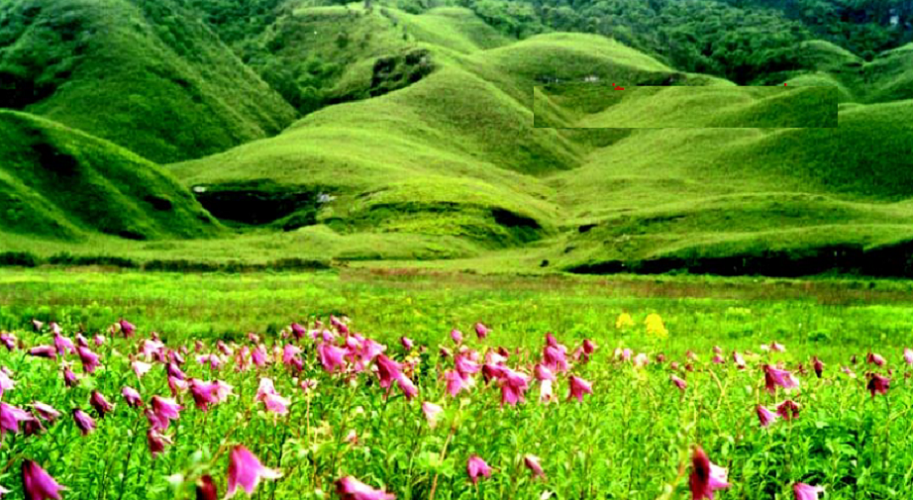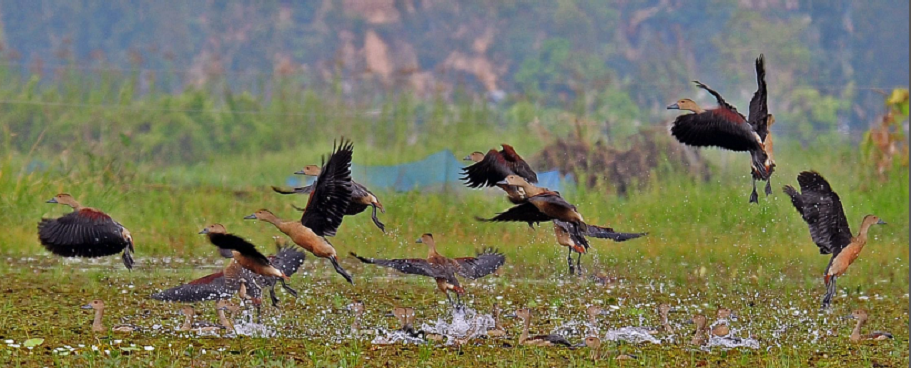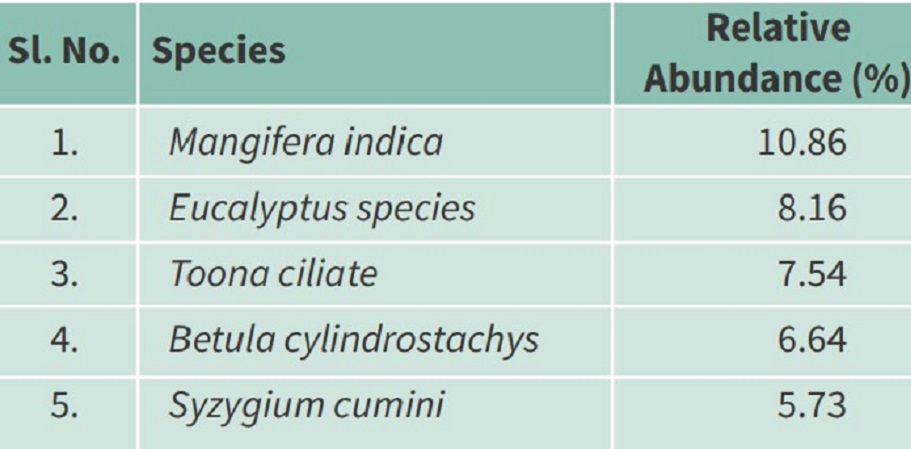Manipur: Flora & Fauna
THIS PAGE IS BEING UPDATED, DISTRICT-WISE
You can update or correct this page, send photographs and/ or |
A: GENERAL
Manipur: Flora & Fauna
Blessed with an amazing variety of flora and fauna, 67% of the geographical area of Manipur are hill tracts covered with green forests. Churachandpur and Tamenglong districts in particular have vast areas covered with bamboo forests. In a small area of about 22,000 sq. km, Manipur has alpine forests of pines, grasslands and meadows at Dzuko and Shirui, coveted the world over. Some of the most beautiful and precious blooms and orchids abound in their natural habitat spreading their beauty and colour, stunning eyes that are not used to seeing them in such profusion.
There are about 500
varieties of orchids
which grow in Manipur
of which 472 have
been identified.
The Hoolock Gibbon, Slow Loris, Spotted Linshang, Mrs. Hume’s Barbacked pheasant, Blyths Tragopan, Hornbills, etc. form only a small part of the rich natural heritage of Manipur. Nong-in is the State bird of Manipur.
The Forests of Manipur
An overview
FOREST DEPARTMENT, GOVERNMENT OF MANIPUR
Resource Richness.....nn
The abundance in the diversity of the forests and its resources are attributed to the ideal location of the state in the junction of two world’s hotspots of biodiversity, the Indo-Myanmar hotspot and the Himalayan hotspot of biological diversity. Out of 34 hotspots across the globe, India has four and out of the four, Manipur has two – Himalayan and the Indo-Burma hotspot. Its biodiversity includes about 4,000 angiosperms, 1200 medicinal plants, 34 species of edible fungi, about 500 orchids, 55 species of bamboo, 695 birds, 160 fish species, 21 migratory aquatic birds and multitude of butterflies, insects etc.
The forests of the State have 6 major Forest Types and 10 Subtypes. The major forest types include Tropical Wet Evergreen Forest, Tropical Moist Deciduous Forests, Sub-Tropical Pine Forest, Tropical Dry Deciduous Forest, Montane Wet Temperate Forest and Sub-alpine Forest.
Legal Status of Forests
The forest and tree cover of Manipur is 77.20 % of the State’s total geographical area. Around 8.42 % of the total forest area is under Reserved Forests including Wildlife Protected Area Network, 23.95 % is Protected Forests and the rest belong to the category of Un-classed Forests.
The Wildlife in Manipur
Manipur is blessed with rich endemic wildlife. Some of them fall under endangered category. It has rich wildlife from big carnivores to micro-fauna.
Among big carnivores, it has
Black Panther
Clouded leopards
Leopards
Malayan Sun Bear and Himalayan Black Bear.
Tigers
Migratory elephants have also been reported in some parts of the State.
It is an important home of endangered and endemic primates i.e.
Assamese macaque
Hoolock gibbon
Pig tailed macaque etc.
Stump-tailed macaque
Manipur is also the home of
6 species of Hornbills and
4 species of Pheasants.
The State falls in the East-Asian migratory flyway of Amur Falcon and many other migratory birds.
The other important wild animals which are endangered or rare and found in Manipur forests, include
Binturong
Himalayan Yellow Throated Marten
Hog Badger
Hog Deer
Monitor Lizards
Pangolin
Slow Loris
Manipur is the home of brow-antlered deer called Sangai (Rucervus eldii eldii), one of the endangered deer species in the world, now available only in Keibul Lamjao National Park of the State. It is also called as Manipur Dancing Deer. The National Park is located in the South-Eastern part of the Loktak Lake, which is the largest natural fresh water lake in North-East India. A unique floating biomass of vegetations, which forms meadows, locally called ‘Phumdi’ plays a crucial role as the habitat of Sangai. It has a combination of aquatic wetland and terrestrial eco-system. This National Park has also been declared as Ramsar site. The Sangai was declared extinct in 1951 and then re-discovered at Keibul Lamjao in 1953. First census of Sangai conducted in 1975, counted 14 heads only. Therefore, the Forest Department took initiative in 1975 and notified Keibul Lamjao National Park in 1977. With intensive in-situ conservation efforts by the Forest Department, the population has grown and as per 2016 ground census, the population of Sangai has reached to 260.
Forests of Manipur: A Mainstay of the Economy
Manipur has more than 77% geographical area under forest cover. Further, about 82% of the State’s forest cover is in Manipur hills. This implies that majority of the population of the State, particularly in hills, is either living in forests or forest fringe. Thus, the socio-economic life of most of the people would invariably revolve around the forests or forest produce.
National Parks, Sanctuaries and Community Reserves
Forest Department has established Protected Area Network over about 3.7% of the total geographical area of the State through notifications of following National Parks, Sanctuaries and Community Reserves for protection and in-situ conservation of wildlife:
Keibul Lamjao National Park, Bishnupur District
Shirui National Park, Ukhrul District
Yangoupokpi Lokchao Wildlife Sanctuary, Tengnoupal District
Kailam Wildlife Sanctuary, Churachandpur District
Jiri-Makru Wildlife Sanctuary, Tamenglong District
Bunning Wildlife Sanctuary, Tamenglong District
Zeilad Wildlife Sanctuary, Tamenglong District
Khongjeingamba Sanctuary, Bishnupur District
Pfunamai Community Reserve, Senapati District
Azuram Community Reserve, Tamenglong District
Chiibvi & Veimairii Community Reserve, Senapati District
Moreover, Forest Department is also maintaining ex-situ conservation sites viz. Manipur Zoological Garden, Captive Breeding centre of Sangai and a State Orchidarium at Imphal. Manipur Zoological garden houses about 50 endemic, endangered or rare species. In State Orchidarium, about 343 orchid species including representative species from hills and valley of Manipur are conserved.
In addition, the Forest Department is also implementing an ambitious project for conservation of migratory Amur Falcon in Tamenglong District. The State falls in the East-Asian migratory flyway of Amur Falcon and many other migratory birds. The conservation of Amur Falcon is significant to secure the agricultural production in the State as it eats on the pests of the crops.
Species
Souces include [https://fsi.nic.in/isfr19/vol2/isfr-2019-vol-ii-manipur.pdf Forest Survey of India/ MANIPUR/ Vol 2[
Inside the Recorded Forest Area
See graphic: ‘Diameter class distribution of top five species inside Recorded Forest Area in Manipur, around the year 2019
Tree species outside forests in Manipur
See two graphics ‘Tree species outside forests (Trees Outside Forests) in urban and rural Manipur, circa 2019’
Major NTFP and invasive species
See two graphics ‘Major NTFP { Non-timber forest product) and invasive species in Manipur, circa 2019’
B: DISTRICT-WISE
Bishnupur
Fauna
Besides the Brow-antlered deer, the fauna in Keibul Lamjao National Park include some very rare animals and it boasts 425 species of animals (249 vertebrates and 176 invertebrates). 35 species were reported to be abundant in the past have declined and are now disappearing gradually.
Chandel District
Like other hill districts of Manipur, Chandel also has varieties of flora and fauna. Various kinds of orchids, ornamental plants and even numerous plants are abundantly grown. Some of the medicinal plants available in Chandel are given below for information.
Flora
Anisomeles indica (Thoiding Amuba: Manipuri) A strongly scented shrubby plant found in Pallel area, is used as an appetizer.
Anotis foetida (Khut-chappi: Manipuri) A small herb found in Sugnu and Pallel areas, its smashed roots are applied to fractured bone which acts as a poultice of plaster of Paris for setting and healing. The same is applied to boils.
Areca catechu (Supari: Manipuri) A slender tall palm, cultivated in Moreh area. Paste of the nut after rubbing on the stone with water is applied to leucodermal patches.
Brucea javanica (Heining: Manipuri) A small deciduous tree found in Pallel, its fruits are used for diarrhoea, dysentery and malignant malaria. Poultice of leaves is applied in skin troubles. Roots are used in bowel complaints.
Crasscephalum crepidiodes (Terapaibi: Manipuri) A herb found in Moreh area, whose lotion of leaves is used as a mild stomachic.
Fauna
The only ape found in India , the Hoolok Gibbon l ocally known as Yongmu, is also found in Chandel district. Similarly, the Slow Loris, the Stumped Tailed Macaque, the Pig Tailed Macaque are the other rare primates that occur in the forests. Sometimes rare nocturnal carnivores, the Clouded leopard and the Golden Cat are also sighted. The gigantic land animal, the elephant, makes seasonal migration into the Indo-Myanmar border areas.
The Himalayan Black Bear is also found in Chandel. The rare and elusive Malayan Sun Bear is restricted to the Unique forests in the Indo-Myanmar border areas. Herds of Bison, as well as of Sambhar, can be seen during night in New Samtal area. Thai Pangolins can also sighted in the Indo-Myanmar border areas which falls under Chandel.
Birds like Pheasant, Burmese peafowl and jungle fowls are also sighted in Chandel.
Wildlife Sanctuary
The Yangoupokpi-Lokchao Wildlife Sanctuary, a protected area network in Manipur, is situated on the Indo-Myanmar border of Chandel. The sanctuary is the home of about 86 species of fishes, 6 species of amphibians, 29 species of mammalians.
Churachandpur
CHURACHANDPUR FOREST DIVISsION, CHURACHYANDPUR
GENERAL DESCRIPTION OF THE AREA AND ITS PEOPLE:
The majority of the villagers were Scheduled Tribes and mostly depends on daily Labour and marginal jhuming for their livlihood.
STATUS OF THE FOREST AREA:
1. Unclassed/ Community forest Land 45.366 Ha.
2. Reserved Forest ( Cheklaphai RF) 8.560 Ha
Total 53.926 Ha.
The vegetation is dominated mostly by herbs, shrubs and young recruits and of plantations by private individuals/villagers. Trees of timber size are not avauilable in the area.
FOREST AND WILDLIFE
Flora
The Flora of the area comprises
Castenopsis Spp,
Emblica officinalis,
Quercus Serrata,
Schima wallichi,
Ground flora incdudes
Clerodendron,
Lantana,
Fauna
The fauna available are
Barking deer,
Jungle cat,
Fox,
Slow loris,
Jungle fowl
No rare and endangered species of flora and fauna found in the area.
PROTECTED AREAS:
No National Park, Biosphere Reserve, Tiger Reserve, wild life Sanctuary and protected archaeological or heritage sites in the area.
Tamenglong
Some thick forest are found in this District. Interior villages like Lemta, Nallong, Kadi, Kuilong, Langpram, Taipram, Inem, Magulong, Phoklong, Zingning, Kakui and Thiulon have thick forests. In the forest different varieties of trees and animals are available.
Rare species like hornbill, hoolock gibbon, slow loris etc are found in the forest.Bamboo, cane etc grow abundantly in the forest. Medicinal herbs are also available in the forests. The region is known for its biodiversity.
Thoubal
Sources include DataBank.Nedfi
Flora
Amla
Bamboos
Banana
Guava
Jack fruit
Kabulliua (Oravila robusta)
Khok (Albizzia Spp)
Lemon
Mango
Peach
Pear
Pineapple
Pipal trees,
Plum
Sileima (Eugenia pracox)
Tairen (Cedrela loona)
Tera (Salimalia Malabarica)
Fauna
Deer
Duck
Fowl, Jungle
Geese
Partridge
Snipe
Ukhrul
An overview
The District is gifted with rich flora and fauna. There are varieties of trees, flowering
plants, orchids of enumerable hues and kinds, epiphetic ferns, varied species of plants
and shrubs. This tropical forest is also the habitat of many valued species of birds and
animals. Ukhrul District is best introduced by its beautiful Shirui Lily, grown only on the
peak of Shirui Kashung, some 18 Km. east of the district HQ. Ukhrul. The rareness and
the uniqueness of this Lily is that, it has seven colours when examined through a
microscope. Shirui Lily was declared the State Flower in 1989 on March 21. Native to
Tangkhul Hills and grown only on Shirui Peak, it is endemic to the region and
considered as the most fabulous wealth of the Tangkhuls.
This district falls under the jurisdiction of Manipur East Forest Division. It has about 77.6 percent forest cover of the total geographical area. Forest provides firewood, charcoal, wood and many other forest resources. As per the State of Forest Reports (1999 and 2001), 1210 sq.km areas were under dense forest in 1999, which had decreased to 1111 sq. km in 2001. However open forest area increased from 2346 sq.km in 1999 to 2415 sq.km. in 2001. Likewise, area under scrubs also increased from 1 sq. km in 1999 to 24 sq. km in 2001. Nevertheless, total forest area in the district has gone down in recent years due to excessive practice of shifting cultivation.
Moreover, forest is one of the most important constituents of the resource base of the district. But from 1997-98, revenue generated by forest has gone down. This may be due to Supreme Court’s ban on the fell of timber
Details
Sources include R Raguis, FLORA AND FAUNA OF UKHRUL DISTRICT, 20 August 2012
The star of course is: Shirui Lily, Lilium Mackleanae Sealy, grown only on the peak of Shirui Kashung
Fish
Barilius guteltus; local name:ngapaila,
Botia species; local name:masengla,
botisdorio,
Chana species; local name:khaiva,
cyprinio semiplotus,
Esomus species; local name:wonsangla,
Gara species,
glyptothorax plailigopanoide,
Golden Mhaseer (Tore Putitora); local name:Ngara,
Mastcembelus; local name:chipang,
Naemecheilus species; local name:hangkorkhai,
Pontius species; local name:khaiwonla and khaipukla,
Snow trout (schizothorax); local name:khainguila,
xenden cacila
Flowers
Lily: Shirui Lily (Lilium Mackelind); local name Kashongwon.
Haramwon of Songrei peak
PLUS
chamtheiwon
Khayawon
kokruiwon (rhodendron)
Muivawon,
nuisiwon
Shilungwon
shiriwon
sikreiwon
Land animals
Threatened species
Bishon or mithun is found mostly at eastern Ukhrul
bears black (big-small and medium)
boars wild
buffalo wild
cat, jungle
deers
elephant Elephants are said to be found in the great Agon Ching range which borders Myanmar
goats wild
leopard
monkey, hooting. Monkeys of toque and baboon species are also seen.
Mouse, field
Otter
pangolin (ant eater)
pig, wild
porcupine Crested
salamander
stag
tiger
tragopan blythii
Trees, plants
Acacia auriculifornis
Albizza Lebbek (Uyil)
Albizzia spp. (Khok)
Alder (Alnus nepalensis)
Bamboo
barderian flowering plants,
Castanopsis spp. (Sahi)
Cmilina arborea
ferns Epiphytic
iris species
Mangifera indica (Heinou)
Mesua Ferrea (Uthau)
Michelia oblanga
Oak
orchids
Paraserrianthes falcotaria
Parkia javanica
Phoeba Hainesiana(Uningthou)
Pine (Uchan)
pinus kerya
Prunus cirosirdes
rhododendrons red and white
robinea psedudoacacia
roses, wild
Symingtonia
Teak
C
Wildlife parks and sanctuaries: India
KEIBUL LAMJAO NATIONAL PARK
Situated 32 kms from Imphal, the capital of Manipur, Keibul Lamjao is the unique habitat for one of the most endangered deer in the world - the "Sangai". Keibul Lamjao is a part of a wide valley with a number of hillocks surrounded by lakes. Loktak lake the largest freshwater lake in India covering 6475 ha. is designated as a Ramsar site. Loktak lake offers a vast diversity of avifauna. Keibul Lamjao is situated in the southeastern part of the Loktak lake.
Sangai live on floating mass of decaying aquatic vegetation and are active at dusk and dawn. Besides the endangered Sangai, one gets an opportunity to watch birds also. International visitors are required to obtain special permission to enter into the national park.
Location
Location: 32 kms from Imphal
Access: 40 sq. kms.
Best time to visit: December to May
Access
By Air - Imphal (32 km)
By Rail - Dimapur (229 km)
Accommodation
Government Rest House and Tourist Lodge
Contact
A.C.F. Keibul Lamjao National Park Manipur









